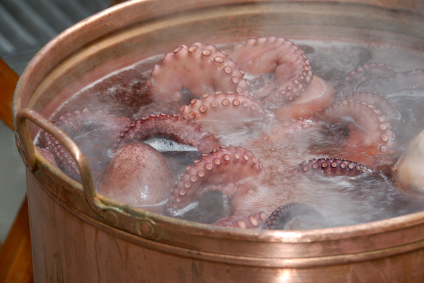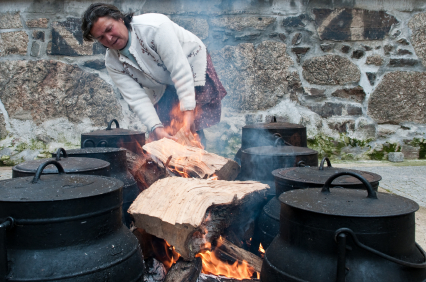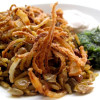We Brits like to think that we’ve got the monopoly on eccentric and it’s even reflected in some of the food festivals you’ll find on this sceptred isle. Take a trip to Wakefield for the annual Festival of Rhubarb, visit the Liquorice Fest in Pontefract or check out the Marmalade Festival in the Lake District – it’s all got that delightfully English pottiness about it. But it’s not out-and-out bonkers; if you want good food, combined with more than a side-order of madness, you need to travel further afield. Next stop: Portugal!
Snails and Plastic Hammers
First on the list has to be Porto’s Festo de São João – one of Europe’s best-kept secrets in the world of food festivalia, probably for fear of the Mental Health Act. The Festo seems to have some religious origins and is thought to be a mix of Christian and Pagan traditions, but these are pretty hard to spot in the ensuing insanity. It takes place on the afternoon of June 23rd, in honour of Saint John the Baptist, and begins reasonably enough with the sort of street festivities you might find at any celebration: a bit of dancing, some drinking and the tantalizing whiff of sardines and meats grilling away in the background. But, once darkness falls, it all gets a bit weird…
Originally, partygoers would come together and hit each other on the head with garlic flowers or leeks. However, the 21st Century equivalent is soft, plastic hammers; as night falls, you can expect to see something out of a Monty Python sketch as revellers get out their plastic boppers whilst chowing down on a skewered fish. Typically, your target is supposed to be someone of the opposite sex, suggesting there’s some fertility rite involved and then, after a parade of whistle-blowing to the riverfront, it’s time for a quick bath in the waters, just as the sun’s coming up. Oh, and let’s not forget that a popular Festo dish is a snail stew. Just in case the rest of the evening isn’t mad enough.
Bagpipes, Kilts and Bulls’ Bits
Tras-os-Montes is cut off from the rest of Portugal and, once you get to grips with what they get up to with their food celebrations, you might understand why. Because it’s a place on its own, the locals developed their own rites and traditions that seem to have nothing to do with anywhere else. Having said that, there is a strong Celtic influence; Tras-os-Montes had more than a few brushes with the Scots and they made their mark.
Christmas is when things really go a bit bonkers, as it also marks a rites of passage ritual for the local bachelors. While the street dances that take place might seem fair enough, it’s the accompanying music and dress that sets the festival apart; only in Tras-os-Montes could you expect to see a bunch of guys dancing ancient steps, wearing kilts and accompanied by the blaring of bagpipes. Most of the revellers are masked, making it hard to know who’s who, but the menu is as far away from our roast turkey and spuds as you could possibly imagine.
 Christmas dinner is, traditionally, a hearty serving of boiled octopus. At least there won’t be any arguments over who gets a leg. But it’s the party food that really stands out; given that there’s a whole ‘rites of passage’ aspect involved, a lot of the food served is thought to have aphrodisiac qualities, such as Túbaros – the fried testicles of a pig or bull, often served up with Salada del Orelha; a simple salad in which the main ingredient is a pig’s ear, fried in olive oil with garlic and herbs. If that all sounds a bit too much, you could opt for Arroz de Cabidela – a simple dish of rice and chicken, elevated to delicacy-status by the addition of the chicken’s blood at a later stage in the cooking.
Christmas dinner is, traditionally, a hearty serving of boiled octopus. At least there won’t be any arguments over who gets a leg. But it’s the party food that really stands out; given that there’s a whole ‘rites of passage’ aspect involved, a lot of the food served is thought to have aphrodisiac qualities, such as Túbaros – the fried testicles of a pig or bull, often served up with Salada del Orelha; a simple salad in which the main ingredient is a pig’s ear, fried in olive oil with garlic and herbs. If that all sounds a bit too much, you could opt for Arroz de Cabidela – a simple dish of rice and chicken, elevated to delicacy-status by the addition of the chicken’s blood at a later stage in the cooking.
Putting the ‘Carne’ in Carnival
The village of Lazarim has its own twist on the idea of carnival. For five days, whether you’re going to work or taking in the sights, you have to wear a mask. These masks are created by the local residents and artists and far from looking like the elegant, cartoonish masks you might first think of, these are actually quite grotesque, often in drab and autumnal colours. The carnival encompasses Shrove Tuesday and while we’re all tossing pancakes, the villagers of Lazarim will gather around a bonfire to hear the reading of satirical wills, which foretell the deaths of a man and a woman, in some sort of explosion. This is all then rounded off with a feast.
The carnival food isn’t your standard hot dog or a burger in a bun. Hit the carnival at Lazarim and you might find yourself tucking into Francesinha – a sandwich aimed squarely at carnivores. Between two slices of bread, you’ll find sausage, grilled beef and a slab of locally-cured ham. Instead of ketchup, it’s soused in a sauce made from tomatoes and beer, smothered in melted cheese and topped off with a poached egg. Alternatively, you might like to try Tripas à Modo do Porto; cow’s stomach cooked with white beans, garlic sausage and tomatoes and served as a stew. See the video below:
However, if you’d prefer a break from the savoury sensory overload, you could always go for the traditional carnival dessert: Pudim Abade de Priscos. Before you get all dewy-eyed about the prospect of a sugared pastry or booze-soaked fruit, think again – the name translates as ‘Portuguese Bacon Pudding’. It’s best described as a sweet, meaty cake served with bacon-infused caramel and honey-baked figs. You could always just eat the figs.
There we have it; before you think that chasing a cheese downhill in Gloucestershire is the height of eccentricity, just be glad that you’re not being followed by a guy bashing you on the head with a leek or a plastic hammer.





